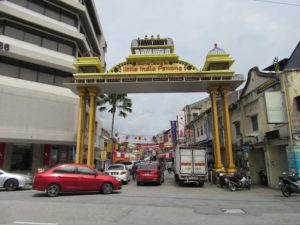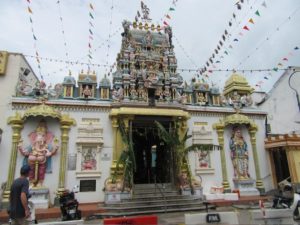By Priyan R Naik
 When I visited Malaysia recently, I was pleasantly surprised to find a ‘Little India’ with a high percentage of Indian businesses and residents, in every major Malaysian city. The colours in these enclaves were amazing, vendors were lugging bales of sarees of all designs and colours through humongous traffic. Glass bangles were found everywhere and food meant having rice on banana leaves served with vegetables, meat and lots of curry, where you had to use your hands to eat as you would in India. Here, ‘snacks’ meant samosas, vadas or gulab jamuns while ‘drinks’ meant lassi either flavoured or plain.
When I visited Malaysia recently, I was pleasantly surprised to find a ‘Little India’ with a high percentage of Indian businesses and residents, in every major Malaysian city. The colours in these enclaves were amazing, vendors were lugging bales of sarees of all designs and colours through humongous traffic. Glass bangles were found everywhere and food meant having rice on banana leaves served with vegetables, meat and lots of curry, where you had to use your hands to eat as you would in India. Here, ‘snacks’ meant samosas, vadas or gulab jamuns while ‘drinks’ meant lassi either flavoured or plain.
When I visited the ‘Little India’s’ of Malaysia, it seemed as if I had never left home, every enclave offering an almost identical experience, reflecting India’s diverse culture through food, shopping, and vibrant community life. Whether in Kuala Lumpur, Ipoh, or Penang, these neighborhoods allowed me to have a glimpse of the rich heritage and traditions of the Indian community in Malaysia!
 The ‘Little India’ in Kuala Lumpur, also known as ‘Brickfields’ was the centre of the brick industry because the soil there is rich in clay and ideal for making bricks, a commodity once in huge demand in a fast-growing Kuala Lumpur of earlier times. Today a vibrant neighbourhood is the largest ‘Little India’ in Malaysia, showcasing India’s culture and heritage. A hub for the Indian community, the enclave features a mix of temples, shops, and restaurants, the streets adorned with colourful decorations. Shopping and dining experiences are truly exhilarating, with several shops selling traditional Indian clothing, jewellry, and spices in the midst of an enticing culinary scene replete with eateries offering authentic Indian dishes including biryani, dosas, and ‘gajar ka halwa’! A stunning temple, the Sri Kandaswamy Kovil, makes for an enduring impression.
The ‘Little India’ in Kuala Lumpur, also known as ‘Brickfields’ was the centre of the brick industry because the soil there is rich in clay and ideal for making bricks, a commodity once in huge demand in a fast-growing Kuala Lumpur of earlier times. Today a vibrant neighbourhood is the largest ‘Little India’ in Malaysia, showcasing India’s culture and heritage. A hub for the Indian community, the enclave features a mix of temples, shops, and restaurants, the streets adorned with colourful decorations. Shopping and dining experiences are truly exhilarating, with several shops selling traditional Indian clothing, jewellry, and spices in the midst of an enticing culinary scene replete with eateries offering authentic Indian dishes including biryani, dosas, and ‘gajar ka halwa’! A stunning temple, the Sri Kandaswamy Kovil, makes for an enduring impression.
I found the ‘Little India’ in Ipoh was much smaller but equally charming in the way in which it reflected the Indian heritage of the city. Located near the city center, it was known for its vibrant atmosphere, a gathering place for the local Indian community. The streets are lined with shops selling traditional Indian textiles, handicrafts and spices, a food scene highlighted by local favorites topped by popular Indian sweets. A temple known as the ‘Kallumalai Hill Temple’ was a significant religious site.
Visiting the ‘Little India’ in Penang was equally thrilling, steeped as it was in history and culture in the most vibrant and colourful part of the city. As part of George Town, a UNESCO World Heritage Site, the enclave was known for its well-preserved colonial architecture, bustling atmosphere and streets filled with the sounds of music, laughter, and the aroma of spices. I found a plethora of shops selling everything from traditional Indian garments to spices and accessories, with renowned dishes offered on banana leaves accompanied with a variety of sweets. One of the best examples of the multicultural fabric in Malaysia, this area adorned itself with one of Penang’s oldest Hindu temples. the famous Sri Mahamariamman Temple and an imposing Kapitan Keling Mosque in close proximity.
The ‘Little India’s’ are clearly demonstrating how a diverse Indian community is contributing to a rich cultural tapestry, boosting local economies, attracting tourists seeking authentic Indian experiences thereby contributing to Malaysia’s tourism sector. These enclaves enhance multicultural understanding by promoting interaction between different ethnic groups even as they are preserving India’s heritage. Discovering a ‘Little India’, in every major Malaysian town made for ample opportunities to poke around temples and markets in the neighborhood, making it inconceivable to feel ‘homesick’!
Regrettably Shillong does not have a ‘Little China’ or a Chinatown in the traditional sense of a distinct neighborhood with a concentration of Chinese businesses and culture, but several Chinese restaurants in areas like Khyndailad (Police Bazaar) and Laitumkhrah more than make up for this absence.



